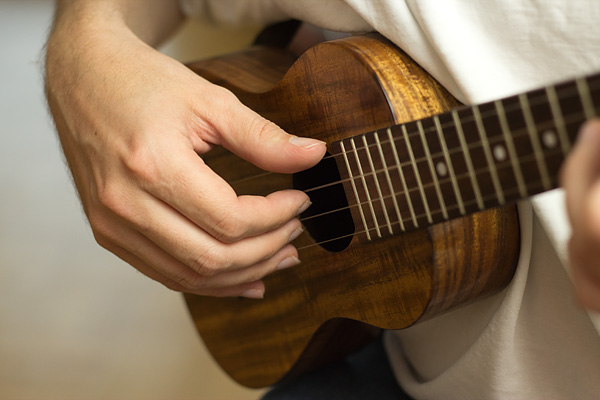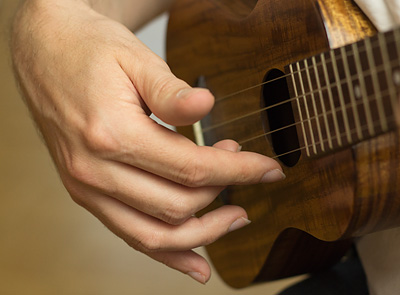Right Hand Technique
The right hand makes the sound
The most important influence for the sound of an ukulele is neither the ukulele itself nor the strings. The sound is mainly generated by the right hand, so right hand technique is the key for the sound of an ukulele.
Nails or Fingertips?
There’s a widely spread preconception that the best sound can only achieved when playing with nails. However, for this purpose, you need healthy, firm nails, which can easily be filed and polished to achieve the required shape and smoothness. There’s no need for particularly long nails, it’s ok if the fingertip touches the string right before the nail. I wrote up here about preparing the nails:
- Nail Care — Preparing the fingernails for playing the ukulele
The alternative is playing with bare fingertips. This is an old technique which was utilized by lute players a long time ago in order to achieve a soft, beautiful sound. For this technique, the nails of the right hand have to be cut very short, so that they are no longer involved into sound generation.
Some people recommend using a plectrum. I personally think that the harsh sound of a normal plectrum doesn’t fit the ukulele well, besides many techniques typical for the ukulele don’t work well with a plectrum. Some players use a felt plectrum, for example to achieve a special jazzy sound when playing chords. However, this is a highly specialized technique which works well for some playing styles, but it isn’t very versatile.
Personally, I (and many other players) prefer playing with nails. However, there are also some really good players who play with their fingertips.
Strumming
For strumming, the movement comes from the wrist. The rest of your arm should stay in place. This is true regardless whether you’re strumming with your thumb only, your index finger, or with multiple fingers.
- Using the thumb: This technique is easy to learn for beginners and doesn’t require long fingernails. The thumb glides softly downwards over the strings. This is done by moving the whole hand with the movement coming from the wrist, while the thumb shouldn’t be moved individually, it just should loosely follow the movement in a passive way.
- Using the index finger: Again the movement should be coming from the whole hand. The index finger should be loosely bent slightly towards the strings. Don’t try to forcefully keep it in this position — let it ease a bit when strumming over the strings. When strumming downwards, only the nail generates the tone. When strumming upwards, both tip and nail should touch the string. In order to get more loudness, strike the strings with multiple fingers: Middle- and ringfinger can be added.
Picking technique
You can pick with the thumb, the index finger, the middle finger, and the ring finger. In notation, following characters are used to denote these fingers:
- Thumb: p
- Index finger: i
- Middle finger: m
- Ring finger: a
Standard posture of the right hand:
For picking solitary tones, the thumb or the index finger is used — no matter which string you want to play. The decision which finger to use depends mostly on which sound color you want to achieve.
For a sequence of notes, you should use alternation: The strings are picked alternately by the index- and middle finger (again, no matter which string you want to play). (There are more advanced alternation techniques too, the basic idea is to avoid using the same finger two times in a row in a rapid sequence of notes.)
Alternation: Index- and middle finger are used alternately.
The movement for picking the strings should come from the metacarpophalangeal joints. (These are the joints between the palm and the fingers.) Try to avoid bending the end joints. Don’t pull the strings away from the sound board when plucking, since this results in a harsh, unpleasant sound. Strike the strings in a way that makes them oscillate in a plane parallel to the soundboard.
The standard position for picking is between the 12th fret and the sound hole. If you want to achieve a particularly bright sound, pick near the bridge. On the contrary, in order to achieve a soft, somewhat “hollow” sound, pick at the position of the 12th fret. Due to the huge difference in sound which can be achieved this way, this is called using the “sonic registers” of the ukulele.
Further techniques
There are many more right hand techniques which I can’t cover here and now, for example:
- George-Formby-Style (Split Stroke, etc.)
- Clawhammer
- Thumb under technique (adopted from lute playing technique)
- Flamenco technique
- etc.
It doesn’t get boring with the ukulele — there’s a vast number of techniques and possibilities!



 English
English  Deutsch
Deutsch